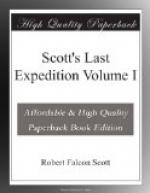’Undoubtedly throughout the winter all ice-sheets move and twist, tear apart and press up into ridges, and thousands of bergs charge through these sheets, raising hummocks and lines of pressure and mixing things up; then of course where such rents are made in the winter the sea freezes again, forming a newer and thinner sheet.
’With the coming of summer the northern edge of the sheet decays and the heavy ocean swell penetrates it, gradually breaking it into smaller and smaller fragments. Then the whole body moves to the north and the swell of the Ross Sea attacks the southern edge of the pack.
’This makes it clear why at the northern and southern limits the pieces or ice-floes are comparatively small, whilst in the middle the floes may be two or three miles across; and why the pack may and does consist of various natures of ice-floes in extraordinary confusion.
’Further it will be understood why the belt grows narrower and the floes thinner and smaller as the summer advances.
’We know that where thick pack may be found early in January, open water and a clear sea may be found in February, and broadly that the later the date the easier the chance of getting through.
’A ship going through the pack must either break through the floes, push them aside, or go round them, observing that she cannot push floes which are more than 200 or 300 yards across.
’Whether a ship can get through or not depends on the thickness and nature of the ice, the size of the floes and the closeness with which they are packed together, as well as on her own power.
’The situation of the main bodies of pack and the closeness with which the floes are packed depend almost entirely on the prevailing winds. One cannot tell what winds have prevailed before one’s arrival; therefore one cannot know much about the situation or density.
’Within limits the density is changing from day to day and even from hour to hour; such changes depend on the wind, but it may not necessarily be a local wind, so that at times they seem almost mysterious. One sees the floes pressing closely against one another at a given time, and an hour or two afterwards a gap of a foot or more may be seen between each.
’When the floes are pressed together it is difficult and sometimes impossible to force a way through, but when there is release of pressure the sum of many little gaps allows one to take a zigzag path.’
CHAPTER II
In the Pack
Sunday, December ll.—The ice grew closer during the night, and at 6 it seemed hopeless to try and get ahead. The pack here is very regular; the floes about 2 1/2 feet thick and very solid. They are pressed closely together, but being irregular in shape, open spaces frequently occur, generally triangular in shape.
It might be noted that such ice as this occupies much greater space than it originally did when it formed a complete sheet—hence if the Ross Sea were wholly frozen over in the spring, the total quantity of pack to the north of it when it breaks out must be immense.




